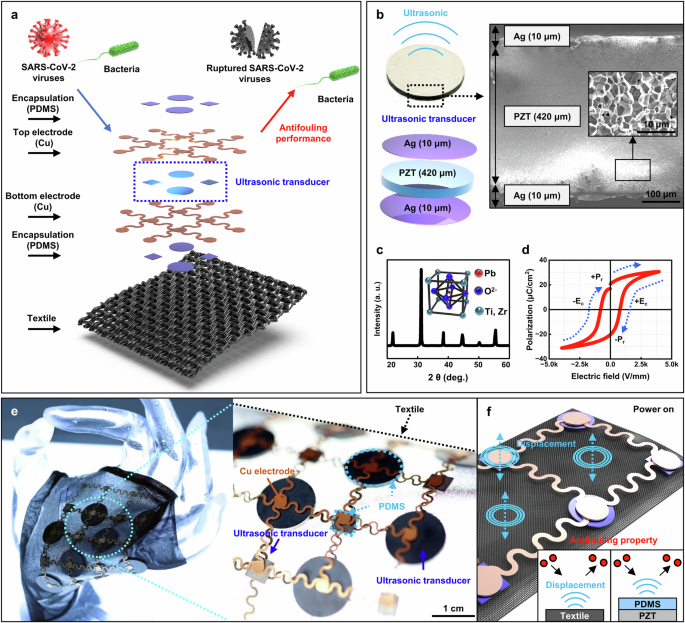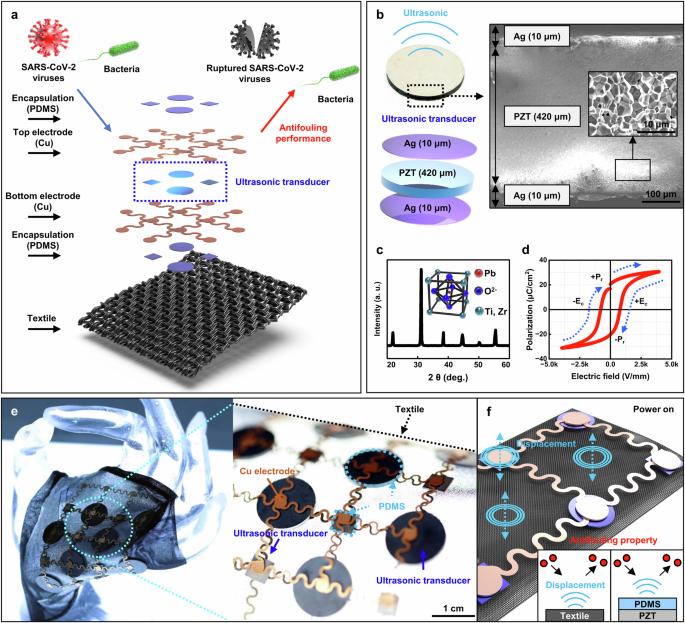Active-type piezoelectric smart textiles with antifouling performance for pathogenic control
IF 12.3
1区 材料科学
Q1 ENGINEERING, ELECTRICAL & ELECTRONIC
引用次数: 0
Abstract
Recently, an investigation into preventive measures for coronavirus disease 2019 (COVID-19) has garnered considerable attention. Consequently, strategies for the proactive prevention of viral pathogens have also attracted significant interest in the field of wearable devices and electronic textiles research, particularly due to their potential applications in personal protective equipment. In this study, we introduce smart textiles designed with optimized piezoelectric devices that exhibit antifouling performance against microorganisms and actively inactivate viruses. These active-type smart textiles, which incorporate advanced lead zirconate titanate (PZT) ceramics, a stretchable interconnector array, and polymeric fabric, demonstrate effective antifouling capabilities, detaching approximately 90% of Escherichia coli and 75% of SARS-CoV-2. Furthermore, they inactivate viruses, releasing ~26.8 ng of N protein from ruptured SARS-CoV-2, using ultrasonic waves within the wearable platform. Experimental results show that piezoelectric smart textiles significantly reduce the spread of COVID-19 by leveraging the electrical and acoustic properties of PZT ceramics.


用于病原体控制的具有防污性能的主动型压电智能纺织品
最近,对 2019 年冠状病毒疾病(COVID-19)预防措施的调查引起了广泛关注。因此,主动预防病毒病原体的策略也引起了可穿戴设备和电子纺织品研究领域的极大兴趣,特别是由于其在个人防护设备中的潜在应用。在本研究中,我们介绍了采用优化压电器件设计的智能纺织品,它们具有抗微生物和主动灭活病毒的防污性能。这些主动型智能纺织品采用了先进的锆钛酸铅(PZT)陶瓷、可拉伸互联器阵列和聚合织物,具有有效的防污能力,可分离约 90% 的大肠杆菌和 75% 的 SARS-CoV-2 病毒。此外,它们还利用可穿戴平台内的超声波灭活病毒,从破裂的 SARS-CoV-2 中释放出约 26.8 纳克的 N 蛋白。实验结果表明,压电智能纺织品利用 PZT 陶瓷的电学和声学特性,大大减少了 COVID-19 的传播。
本文章由计算机程序翻译,如有差异,请以英文原文为准。
求助全文
约1分钟内获得全文
求助全文
来源期刊

npj Flexible Electronics
Multiple-
CiteScore
17.10
自引率
4.80%
发文量
91
审稿时长
6 weeks
期刊介绍:
npj Flexible Electronics is an online-only and open access journal, which publishes high-quality papers related to flexible electronic systems, including plastic electronics and emerging materials, new device design and fabrication technologies, and applications.
 求助内容:
求助内容: 应助结果提醒方式:
应助结果提醒方式:


